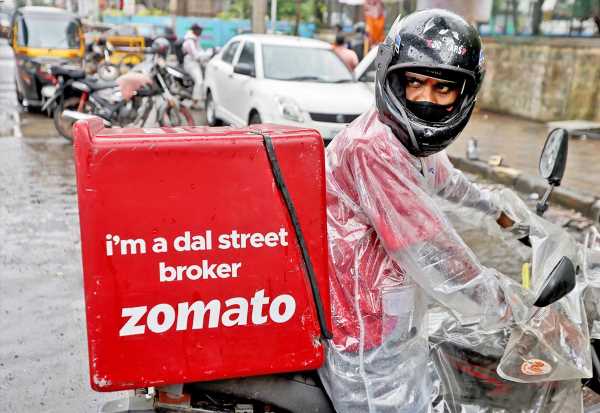As the industry-wide slowdown in food delivery business continues to affect Zomato’s numbers, with the food aggregator’s losses widening to Rs 346.6 crore in the third quarter of the fiscal year (Q3FY23), the firm’s side ventures-Blinkit, Zomato Gold and Hyperpure-continue to outshine its core business.
According to brokerage firm Nomura, Zomato’s gross order value (GOV) in its food delivery business disappointed in a seasonally strong quarter.
“Zomato’s food delivery business grew a modest 0.7 per cent quarter-on-quarter (QoQ) and 21.5 per cent year-on-year (YoY) compared to 3 per cent and 10 per cent QoQ in Q2 and Q1, respectively. On a QoQ basis, monthly transacting users (MTU) and the number of orders declined while average order value (AOV) increased,” it said in a note.
“Growth slowdown to 0.7 per cent in a seasonally strong quarter is very sharp. Growth revival through relaunching the Gold loyalty program is likely to delay a continued recovery in contribution margin,” the note added.
Blinkit
Zomato’s quick commerce arm Blinkit saw its GOV increase 18 per cent QoQ, driven by a 21 per cent growth in order volumes. This, the firm believes, compensated for reduction in AOV, which fell to Rs 55.3 crore in Q3 from Rs 56.8 crore the previous quarter.
“Growth in revenue per order led to a higher revenue growth of 28 per cent QoQ. The growth has come without any expansion in our dark store footprint as evident from the increase in the GOV per dark store,” said Albinder Dhindsa, chief executive officer (CEO), Blinkit.
Blinkit was also able to attract a huge number of advertisers on its platform, a number which was shared by the company for the first time.
The management said that more than 500 brands currently use the platform for advertising and engagement. Advertisement revenue has, therefore, been a meaningful source of income for the quick commerce business.
Though Blinkit’s addition pulled the consolidated profits down, profitability of the unit continued to improve with contribution margin (as a per cent of GOV), improving from 7.3 per cent in Q2FY23 to 4.5 per cent in Q3FY23. Adjusted EBITDA loss decreased from Rs 259 crore in Q2FY23 to Rs 227 crore.
“We are an early stage business. So any macro slowdown doesn’t have a visible large-scale impact on our growth metrics. Blinkit is also less impacted vis-à-vis the food delivery business as our typical purchase basket tends to be more skewed towards essential / non-discretionary spends,” Dhindsa added.
He also said that brands can get visibility on consumption trends at a neighbourhood level. In addition, delivery in minutes means that customers are buying the products only minutes before consuming them.
“As we are so close to the point of consumption, brands have been using Blinkit effectively for new launches as they are able to create buzz around the product with a faster product feedback loop,” he said.
“We expect advertisement revenue to be a significant driver for increase in revenue per order,” added Dhindsa.
Zomato Gold
Zomato launched its premium membership program, Zomato Gold, in late January. The plan was discontinued almost two years ago. In less than a month, the program has already scaled to 900,000 members, the company’s CEO Deepinder Goyal revealed in a regulatory filing. “We expect this program to drive loyalty and higher frequency of ordering going forward,” he said.
Although the subscription offering caused a short-term negative impact on the company’s margins due to the free delivery benefit, management believes that this will be offset by improvements in other revenue and fixed and variable cost drivers.
“In the long term, we believe we will be able to make the Zomato Gold program itself profitable,” said Akshant Goyal, chief financial officer (CFO), Zomato.
“Our business is already break-even ex-quick commerce last month (January 2023), and there is a good chance of getting to adjusted EBITDA break-even (ex- quick commerce) in the current quarter if we are able to bank some execution related wins in the next few weeks (which should offset the negative impact of Zomato Gold on our margins),” he added.
Hyperpure
The firm’s business-to-business (B2B) venture Hyperpure also saw its revenue grow 26 per cent QoQ, and 169 per cent YoY, to Rs 421 crore in Q3. Losses stayed flat and adjusted Ebitda margin improved 13 per cent in Q3 as compared to 16 per cent in Q2.
Although the business, which was considered the key driver of profitability for Zomato, has not witnessed remarkable growth, the management believes the venture will turn profitable in the long term.
“There is evidence to long-term profitability, given our oldest city is already near profitable. Over time, it will drive higher consumption of restaurant food as we positively impact the quality of produce used at restaurants,” Deepinder said.
The company has opted for growth over profitability in its B2B venture for now. This, Goyal says, is “because Hyperpure is a multi-city business with each city at a different stage on the profitability curve.”
“Our oldest city Bangalore (4+ years old) is already close to being profitable, and hence, the newer cities are the largest contributor to losses in this business,” he revealed.
Hyperpure’s synergy with Blinkit has also paid dividends for the firm. “Hyperpure has also begun tapping into quick commerce. Part of the revenue growth in Q3 was on account of goods supplied to the sellers on Blinkit’s marketplace. Hyperpure is well placed to monetise this opportunity given its strengths around sourcing and supply chain,” Akshant added.
Source: Read Full Article
-
Settlement reached in Shotgun Willie’s wrongful death case
-
Elon Musk Initiates Radical Rebranding: Twitter's Iconic Bird Logo Replaced With X
-
U.S. Stocks Move Sharply Lower Amid Renewed Interest Rate Concerns
-
One Reason the U.S. Can’t Quit China? Chips.
-
U.S. Stocks Regain Ground After Early Sell-Off But Close Mostly Lower

